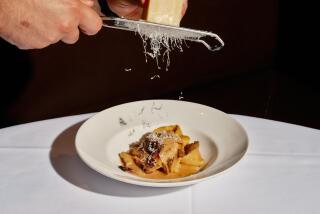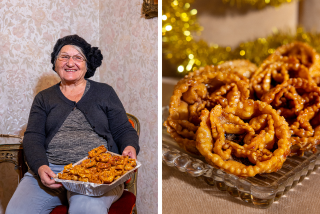Enjoying More of Life for Less in Northern Italy
TRENTO, Italy — With just the tiniest bit of imagination, one can picture this town’s main square as an opera set, with the majestic Romanesque-Lombard cathedral forming a backdrop to one of Giuseppe Verdi’s tragic dramas of love and treachery. Even the baroque fountain at the piazza’s center, La Fontana del Nettuno, has the ring of a Verdi title.
Trento, an intimate little city on the Adige River that belies its population of 100,000, is capital of the Trentino province, one that has--along with other Italian regions in the shadow of the Dolomites--seen its share of conflicts, thanks to the imperial designs of the Austro-Hungarian Hapsburgs who ruled much of Northern Italy and Yugoslavia until the end of World War I.
What draws visitors, most of whom (80%) are Italian, to Trentino’s Adige Valley and the surrounding mountains is a panoply of sure-fire attractions: magnificent mountain scenery, terraced vineyards that seem to climb every hillside, 300 sparkling lakes plus a network of rivers and streams, museums, monasteries and 120 lordly old castles, 25 of which (plus seven palaces) will resound to concerts and other musical and dramatic performances throughout the summer.
Trento and other towns and villages of the region have other virtues as well, not least of which are prices averaging 30% less than those one finds on the Rome-Florence-Venice track. In today’s Italy and in most of Western Europe, this is a distinct attraction not to be taken lightly.
During our three years of living in Verona, a scant 60 miles south of Trento on the Adige, we made many trips through the Adige Valley for skiing in Trentino’s beautiful resorts of Madonna di Campiglio or Canazei near Mt. Marmolada. On such trips we always tried mightily to schedule a stop in Trento, one of Northern Italy’s most unsung yet enchanting towns.
How long/how much? Give Trento a full and leisurely day, plus one or two others for exploring the castles and villages of surrounding mountains and valleys. Lodging costs here are moderate, dining very well the same.
Getting settled in: Hotel Aquila d’Oro, at the heart of town near the cathedral, is a small (18 rooms), contemporary place in a historic building that has been totally renovated within. Bedrooms are large and handsomely decorated, with king-size beds, TV, mini-bars and wonderful views of the nearby palaces and cathedral. The rooftop breakfast room (breakfast is the only meal served) has even more spectacular views of the city.
Villa Madruzzo, a handsome old manor house in Pompeii red, set in a magnificent park and gardens, is less than two miles from Trento in the hills just off the Venice road. The villa has its own chapel, library, tennis courts, an imposing cupola and marble statues at the points of its gable roof. Villa Madruzzo is where the region’s beautiful people have wedding receptions and other such affairs.
Hotel Capitol, on the Verona-Brenner Pass autostrada, is perfect for drivers or anyone traveling with children (pizzeria next door). It’s a large, motel-like place next to a shopping center, with modern decor throughout the bedrooms and public areas, all the amenities, an espresso bar off the lobby and a full restaurant. Be sure to ask for a room in the back to escape roadway noise.
Regional food and drink: Trentino’s cooking is simple and straightforward, having slight Tyrolean overtones in the presence of dumplings (canederli) and other mountain fare. Gnocchi (small dumplings made of flour or potatoes) are ever-present on menus, and Northern Italy’s polenta (a finely ground cornmeal mush) can become addictive, particularly when cut into flat squares and warmed in the juices of mushrooms, game or other meats.
Try the region’s strangolapreti (spinach dumplings), fresh trout, venison (usually available) and Trentino’s acclaimed grana cheeses, either grated or in thin slices anointed with virgin olive oil.
The region’s fine wines never seem to receive their just due outside Italy, which is a pity. Try the Nosiola, a delicate and fruity white; Chardonnay Trentino, a dry and very good white, and Teroldego Rotaliano, a robust red grown just outside town. And we were particularly impressed by the wonderful reds produced by the Donati family in the nearby town of Mezzocorona.
Now that a taste for grappa (a distilled wine and often harsh after-dinner palliative) has finally reached chic stateside watering holes, have a go at it in a town that’s been making the stuff for centuries, with one local wine shop stocking 50 varieties.
Good local dining: Ristorante Roma (Via S. Simonine 6) is one of the town’s most popular spots, always filled with locals for its typical Trentino dishes. It’s a bright and attractive place, with fresh roses on each table beside a silver bowl of grissini. Waiters couldn’t be more helpful.
For starters, try the tagliolini with breast of goose, carpaccio (with olive oil and grana) or wild boar prosciutto, all in the $6.50 range. Main dishes include a Trento plate (local specialties), veal cutlet, mixed grill of local fish and an entrecote with red peppers, all about $11. You’ll be happy at the Roma.
Late diners will love La Cantinota (Via San Marco 24), the vaulted cellar of a 16th-Century building again near the center of the old town, open until 3 a.m. The big thing here is pasta, including tortellini ai funghi (with mushrooms) for $9.50; fettuccine with salmon, $9, or just about any version of spaghetti you might desire for $6. Cantinota is a very intimate and romantic place, with soft piano music and a distinct medieval feeling.
Worth every second of the 15-minute drive from town is El Volt (in the village of Palu di Giovo in Cembra Valley). Park your car and walk through vineyards and a cherry orchard to the rustic cellar of a 15th-Century farmhouse. Here you sit down to a six-course meal of whatever Maria and her sister Pia have prepared, using only ingredients from their farm and wine from the vineyards. Figure about $23 per person.
It’s very important to call ahead (0461-684132) or have your hotel make arrangements beforehand, since El Volt seats only 20 people, and Maria and Pia only cook for those coming for lunch or dinner. We recommend lunch so as to appreciate the beauty of the farmhouse wreathed in flowers and the garden.
Going first-class: Albergo Accademia, in a medieval house at town center, is an absolute charmer owned and managed by two sisters who have decorated it exquisitely. While the flavor is a gentle blend of the old and new, mixing fine oriental rugs, hand-woven fabrics and vaulted ceilings with contemporary Italian furniture, the overall effect is one of supreme elegance.
There’s an inner courtyard where one can take breakfast under a chestnut tree, or repair for an early evening drink to the rooftop terrace, with incredible views of the cathedral, town and surrounding mountains.
Osteria a le Due Spade (Via Don Rizzi 11), in a building that went up in 1545, is said to be the best restaurant in Italy north of Venice. It’s owned and managed by a family that has had restaurants in several major European cities, and everything about the place is engaging, from the yellow roses on each table to the wildflowers garnishing plates from the kitchen.
Two five-course fixed menus are priced at $52 and $44, not necessarily a bargain but a pleasant surprise these days for food, service and ambience of this quality and flair.
On your own: Everything in the ancient part of Trento is hardly more than a 100-yard walk away, so a day’s stroll should take in most of the sights. Start with the Piazza del Duomo (Cathedral Square), then make time to step into the Diocesan Museum for a look at half a dozen marvelous Renaissance tapestries. Nearby Via Belensani, with its impressive lineup of Venetian-style palaces, is also worth a walk-through.
During your walk, stop in at Pasticceria Bertelli (Via Oriola 29) for the best cup of coffee in town and superb pastries. Owner Riccardo Bertelli is all charm and good spirits, probably accounting for its popularity with locals. A few steps away on the same street you’ll find the Lunelli Wine Shop, housing a truly formidable selection of bottles from every region of Italy, including those 50 kinds of grappa.
From June until September, the castles of Trentino present concerts, chamber music, ballet, folk groups and other companies from around the world. Many of these performances are free, others ranging in price up to $20.
The best place to sense the pulse and personality of a town and its people is still in the street markets, and you’ll find a daily flower, fruit and vegetable market in the shadow of the cathedral (the full market is on Thursdays). The display of cherries, huge strawberries, wild mushrooms, farm salamis and sausages, Trentino cheeses and freshly picked chamomile for making tea is a colorful and joyous sight not to be missed.
GUIDEBOOK
Northern Italy
Getting there: Fly Alitalia to Milan or Verona, or TWA, Pan Am or American to Milan. An advance-purchase, round-trip fare to Verona is $1,334 with Alitalia, about $100 less to Milan. Rail connections are better and faster from Verona, a main north-south rail route.
A few fast facts: Italy’s lira recently sold for 1,229 to the dollar, about .0008 each. Best time for a visit is from June until October. Northern Italy can be dismal until June, often late June, but fall is glorious.
Accommodations: Hotel Aquila d’Oro (Via Belenzani 76, $111 double); Villa Madruzzo (Cognola di Trento, $99 B&B; double); Hotel Capitol (Gardolo, Via Soprasasso 32, $74 double); Albergo Accademia (Vicolo Colico 4, $148 B&B; double).
For more information: Call the Italian Government Travel Office at (415) 392-6206 between 9 a.m. and 1 p.m., or write (360 Post St., Suite 801, San Francisco 94108) for a 24-page booklet on Trentino, with map, another of general information on travel in Italy. Also available are a limited supply of brochures on the city of Trento.
More to Read
Sign up for The Wild
We’ll help you find the best places to hike, bike and run, as well as the perfect silent spots for meditation and yoga.
You may occasionally receive promotional content from the Los Angeles Times.






